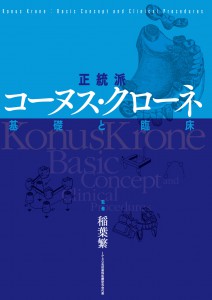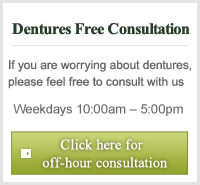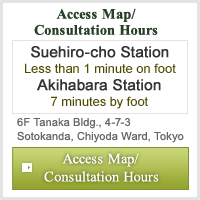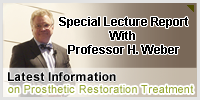2015年10月23日
What about the lingual bar in the lower jaw?
Q. I want to ask about the use of and awkwardness that may accompany a lingual bar in the lower jaw. Will food get stuck in there? Will it affect my pronunciation? Won't it feel awkward when I touch it with my tongue?
A. The lingual bar is a bar that connects the false teeth on the right to the ones on the left.
General bars covered by insurance are prefabricated and made by bending wires. They are not very strong and bend easily. There are times when they are only used temporarily, but sometimes long-term use is recommended.
Lingual bars from our clinic are order-made from a company that specializes in metal flooring. They are extremely durable and will not bend or break since they are cast according to the shape of the patient's jaw. Since we can have them made thin, there is almost no awkward feeling to them at all. The lingual bar is positioned in the lower area of the jaw meaning that there is minimal interference with pronunciation, it is easy to clean, and there are no crannies for food to get stuck in.
*Here is feedback from an actual patient at our clinic whose Riegel telescope dentures have a lingual bar.
It was a little heavy at first, but after a few days the awkwardness faded and I gradually got used to it. It makes my false teeth feel firmly in place and gives me a stable bite. Food never gets stuck under it so it is never on my mind.
I am able to use my dentures every day as if they were a part of my body and so I am very happy to have had this treatment. These dentures are very precise so I will come in for maintenance without fail.
2015年6月 3日
Questions Concerning Dentures Contents
General Denture Treatment
Post Treatment with Dentures
Worrying about Implants
Overseas Inquiries
2015年5月28日
Our Supporting Staff
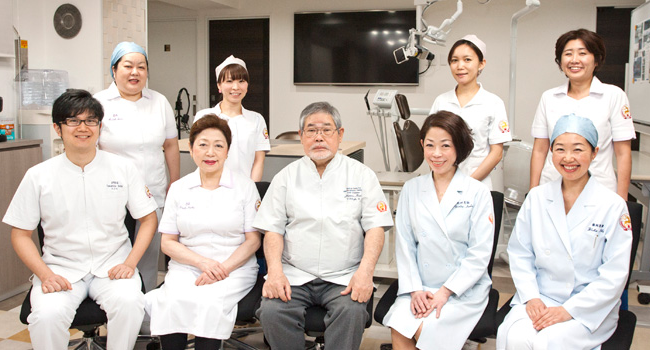
We are one big family at Inaba Dental Office.
We always greet our patients with a big smile.
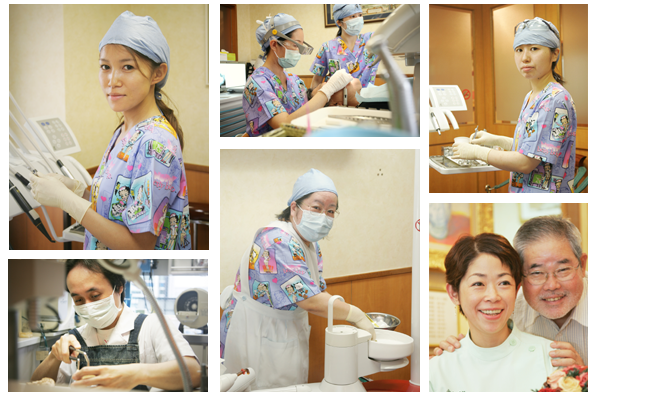
2015年5月27日
To patients who wish to come and visit us for treatment from abroad.
As for our responses to you coming from abroad, we contact your email address for further information on visiting plans from abroad.
Our treatment is done on appointment basis, and we can arrange your time scheduling of intensive care if you fix it prior to leaving back for home.
Our treatment plan of telescope denture system, however, will take complicated time management for production at our dental lab. It depends on clinical cases, but normally 4 time appointments will be needed from impression taking to finish.
2 or 3 weeks of well-planned and concentration of dental technician's handiwork will be needed in between production sequences. (In case of complete dentures, consecutive 3-day finish course is available.)
Normally our telescope denture system will be still difficult to finish even within one month period of your stay.
So patients who come and visit us from abroad will need to make at least 4 times of visit appointment, whichever you choose to stay or go back and come back again.
We would appreciate your consideration to keep this information in mind.
Return to page, Application form for free consultation of denture making
2015年5月26日
Dr. Yuka Iba,
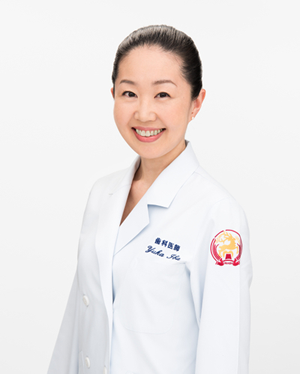 Dr. Iba has been my best friend since were in college. We have enjoyed many things such as taking international trips together for the last 20 years. While working at the clinic we both put on our doctor faces but when we go out together after work we like to relax and be ourselves. Dr. Iba is a wonderful dentist whom I put my whole trust in. She is kind and polite and tour patients trust her completely. She has many fans among our patients! Dr. Iba has a message for all of our patients!
Dr. Iba has been my best friend since were in college. We have enjoyed many things such as taking international trips together for the last 20 years. While working at the clinic we both put on our doctor faces but when we go out together after work we like to relax and be ourselves. Dr. Iba is a wonderful dentist whom I put my whole trust in. She is kind and polite and tour patients trust her completely. She has many fans among our patients! Dr. Iba has a message for all of our patients!
[Message]
This spring marks 15 years since I started working at Inaba Dental Office. Our director, Dr. Yuriko, is a superior who I have always looked up to throughout our last 20 years of studying together and being friends. And, our advisor, Dr. Shigeru Inaba, is the dentist who I respect more than anyone. Back when I was a dental student and couldn't tell left from right, he thoroughly taught me all the fundamentals of dentistry. It is thanks to Dr. Inaba that I am the dentist that I am today. After graduating Nippon Dental University and taking a position in geriatric dentistry at the adjoining university hospital, I have had the opportunity to improve my skills and practice what I have learned starting with treating elderly patients with systemic illnesses. I take the time to listen to patients' worries and requests and include them in the process of figuring out the best treatment option. My goal is to help patients through treatment as if we were one in the same person.
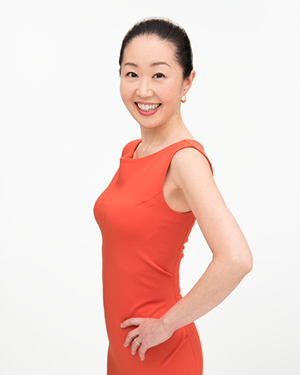 [Private]
[Private]
I love to go on trips. In fact, just the other day I finished a 2 week trip to the South Pole. My treat to myself is leisurely spending time surrounded by nature. I enjoy long walks in the green woods, refreshing dives in the blue sea, soaking up the morning sunlight, experiencing every moment of every day in health, and gazing at the setting sun. Nature is the best!
Dr. Takahito Sato
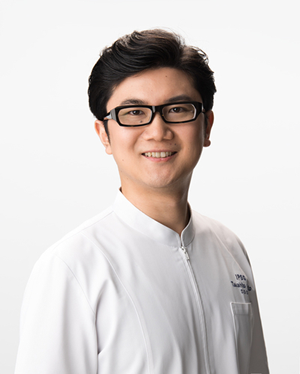 He is our young hope, not only at Inaba Dental Office, but also at IPSG Interdisciplinary Practical Study Group. Please allow me to introduce Dr. Takahito Sato. Studying is his hobby. At least that is what it looks like since he faithfully attends our research meetings every weekend to improve his skills (haha). Many patients come from far off places, including overseas, to be treated by Dr. Sato. I find it wonderful how diligent Dr. Sato is in arranging his own affairs around his patients' schedules to make sure that they feel taken care of. In his private life he is good at making people laugh with his impressions. Here is a message from Dr. Sato to all of his patients.
He is our young hope, not only at Inaba Dental Office, but also at IPSG Interdisciplinary Practical Study Group. Please allow me to introduce Dr. Takahito Sato. Studying is his hobby. At least that is what it looks like since he faithfully attends our research meetings every weekend to improve his skills (haha). Many patients come from far off places, including overseas, to be treated by Dr. Sato. I find it wonderful how diligent Dr. Sato is in arranging his own affairs around his patients' schedules to make sure that they feel taken care of. In his private life he is good at making people laugh with his impressions. Here is a message from Dr. Sato to all of his patients.
[Message]
From the time that I was a college student up until the present, I have not only studied dentistry technology under Dr. Shigeru Inaba, our office's advisor, but have also studied the philosophy of dentistry. I started my career in the geriatric dentistry department of the Tohoku University Hospital after graduating college. There I received extensive training in various fields including oral surgery, and after that I took my position at Inaba Dental Office. In order to provide the best treatment for patients I attend research conferences and training monthly outside of my normal working hours. Oftentimes I receive feedback from my patients in the form of surveys. One comment that stood out to me said, 'I am happy that he describes the treatment process in detail as we move forward.' As the comment states, I always make it a point to advance treatment while keeping the patient's worries in mind. It is important to balance the physical health aspect of treatment with the mental aspect. I believe that through this, not only can I provide the best possible treatment for my patients, but also my patients can see that I include them in even the most trivial aspects of treatment. This puts my patients at ease since they feel included in the treatment process.
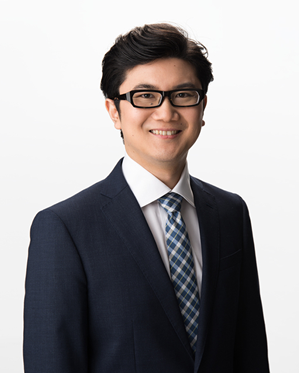 [Private]
[Private]
I enjoy interacting with nature and cooking. This is how I unwind after work. On my days off I like to go to Mt. Takao in Tokyo or other natural spots. On longer vacations I like to visit onsen in Tohoku. I also like to go on hikes while in that area. I also like to make food and eat food. I get particularly fired up when enjoying barbecues in nature. Also, I like to eat whatever food is in season and my favorite is bamboo shoots in spring. Why don't you join me sometime to unwind in nature!
Dr. Kosuke Konishi
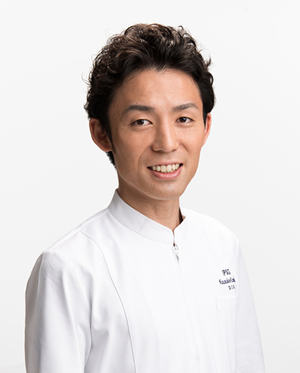 Inaba Dental Office, stage 2 of doctor introductions begins with...
Inaba Dental Office, stage 2 of doctor introductions begins with...
Dr. Kosuke Konishi!
When I first saw the diligent Dr. Konishi studying at the IPSG Interdisciplinary Practical Study Group, led by Dr. Shigeru Inaba, our advisor, I knew that he was the dentist that we wanted to work at our office. That was 2 years ago. And finally this past April we were graced with his presence. He is very honest which is why many patients feel safe entrusting him with their treatment. It is also nice that sometimes he brings his own handmade lunch to work (haha). Dr. Konishi! We are looking forward to your hard work here ;). We also have a message from Dr. Konishi to his patients.
[Message]
When I treat patients, I think of them as my own family. This means that I strive to provide the best medical care to each of my patients. Of course treatment technology is extremely important. But I prioritize communication with the patient throughout treatment above all else. Each one of my patients is my treasure and so I advise them on the best treatment methods. Provide sound support during the treatment process goes without saying. But it is after treatment is over that I believe a long-term relationship with the patient is important. Please come to me with any worries or requests that you may have. I aim to be a sensitive and friendly dentist.
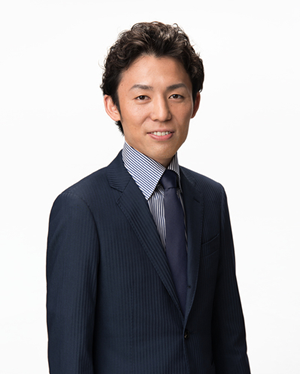 [Private]
[Private]
Recently I have taken up cooking.
Actually, I am a beginner and just the other day I made hamburger for the first time in my life (haha).
I am looking forward to trying my hand at various different dishes.
2015年5月21日
Overseas Inquiries
I am resistant to the idea of getting a bridge that requires tooth filing on both sides of my mouth. (person currently residing overseas for work)
I live in Guam. Please tell me about the treatment process.
I am currently living in Singapore. How long does it take to make dentures?
I am currently living in Indonesia. I am worried because my teeth keep falling out.
What do I need to prepare and how should I contact you before returning to Japan? (person living in Canada)
What is the biggest difference between the Riegel telescope treatment method and a bridge? (50 year old living in Hawaii)
2015年5月20日
I am resistant to the idea of getting a bridge that requires tooth filing on either side of my teeth. (person currently residing overseas for work)
Q. I would like to hear your opinion about getting a single false tooth for my front tooth.
I am currently residing overseas. 10 years ago I had to get false teeth for both of my front teeth. About one week ago my left front tooth became loose and the gums around it became inflamed. I immediately headed back to Japan but on the way back the false tooth broke so I just pulled the whole thing out. I decided to get a bridge.
But I am resistant to the idea that the teeth on the left and right are going to have to be filed down. If it is possible to treat a single tooth with Riegel telescope, could you please let me know what is involved? Since you say that 'there are no visible wires', I would like to know the difference between this treatment and general false teeth that are held in by wires.
I would like to meet for consultation the next time I go back to Japan.
Thank you for taking the time to answer my question.
A. Thank you very much for contacting us. It must be stressful having to deal with such problems while residing overseas for work.
As far as filing goes, the Riegel telescope method requires the same amount as implants. Filing teeth does not damage them in any way. After thorough examination we would determine the best configuration for anterior guidance, fix the tooth in place as firmly as possible, and adjust for maximum functionality and esthetic beauty.
Clasp dentures with wires do not sit very firmly and they wiggle a lot. This causes the supporting teeth to wiggle as well and even the teeth next to the supporting teeth are wiggled. There is also the esthetic problem which will leave you constantly worried about your smile.
If you seek treatment at our clinic, we will try our best to reduce the number of visits you need to make here, and we can even schedule one long treatment session, set a plan, and proceed as quickly as possible.
We do not usually use Riegel telescope on cases involving only 1 tooth. It is more suited to cases of 2 or more missing teeth.
The difference between Riegel telescope and wired false teeth covered by health insurance is the fixed power. Riegel telescope dentures will not wiggle like a bridge does. Wires hold with a looser grip and surrounding teeth receive a lot of stress which may lead to further tooth loss.
Many potential patients residing overseas are hesitant to receive dental treatment. But we can conduct consultation through mail so please do not hesitate to contact us with any questions.
2015年3月10日
I can't believe how much they are growing on me.
Dear Dr. Yuriko,
My Riegel telescope dentures are truly wonderful! Day in and day out they function as a part of my body. Thank you so much, Dr. Yuriko. Not only for treating me, but also for being my dentist.
I am writing about my experience so that it can be used as a reference by other people who are worrying about the condition of their teeth.
How I came across Inaba Dental Office
My teeth have had problems since I was a child, but I was always afraid of the dentist.
I know I should have visited the dentist a few times every year, but I don't even remember the face of the dentist I was going to or even how his examination room was decorated! (I must have been terrified. It's quite a mystery.)
When I was around 30 years old, I mustered up my courage and spent a whole year getting my upper and lower jaw treated. At that time, the lower jaw, in which I recently had false teeth put in at Inaba Dental Office, needed a bridge for the molars on the left and the right. Since that time, I had gone in for overall checkups and plaque removal about once every 3 months, and I was able to avoid any major treatment for about 10 years.
When I was about 43 years old, I remember feeling an awkwardness in the teeth on one side of my jaw while eating, (I think it was while eating something hard?) I went to the dentist and he told me that my bridge was broken.
I had to get partial dentures but they hurt so bad that I could not bite. The teeth supporting the clasps that were holding my false teeth in place began to hurt so bad so I eventually gave up on even wearing my dentures. It became harder and harder for me to continue to go to the same clinic even though I had always gone for scheduled checkups before. It is no wonder the bridge on the other side broke as well after one year since I was chewing everything on that side of my mouth (by that time, I had completely stopped using my dentures).
As you would expect, I began to think about various ways to take care of this. I visited a clinic to discuss getting implants, but it became clear that implants were not a viable option. (I would have needed multiple surgeries to increase the amount of bone in my jaw so that I had a place to stick the implants in. This part of the treatment alone would have taken a year and a half and there was no guarantee that it would have worked.) Also, at that time, my fear of dentists came back strong. It was so scary. I couldn't even look at the dentist's face when talking to him. I started to look all over for information about dentures and that is when I found the homepage for Inaba Dental Office!
At Inaba Dental Office
I was a little lost at first because the clinic is so far from where I live. But after reading the information of the homepage I decided that I should try to go in for consultation. That was when I first decided to come in.
My first meeting time meeting Dr. Yuriko!
She kindly listened to my history and my worries and politely answered my questions. After that she explained to me, what she thought would be the best treatment for me at the time and also down the road. I was so relieved after she explained to me clearly all of these things and told me how long treatment would take and how it would proceed. All of my anxieties were put to rest and I felt like I could leave everything to Dr. Yuriko.
So I decided to begin treatment on my next visit.
I went to the clinic at a pace of once every 1 or 2 months (She was very sensitive to the fact that I lived far away and insisted that we schedule appointments that did not conflict with my schedule, even if this made her schedule more busy) and within half of a year my dentures (Riegel telescope) were complete. This concludes the story of how I got my dentures.
The reason why I felt safe leaving everything to Dr. Yuriko was not only that she made me a wonderful set of dentures (they gave me a better bite and are protecting my remaining teeth), but also she, her staff, and the clinic in general provided such a warm atmosphere. Every time I went there, I felt more courageous. In fact, the first time I ever shed tears before a doctor as an adult was at Inaba Dental Office.
And those tears were not because I was afraid, but because I was so happy. The treatment itself was superb but what was more was that they were concerned about how I would spend the next day after treatment without any inconveniences. When treatment went smooth and finished before schedule, they always tried to help me enjoy Tokyo, since I had come from so far. They always made me feel warm and welcome even though I was far from home.
Everyone probably has their own way of choosing a doctor, but I can truly say that the doctors at this clinic are happy to be dentists and put themselves in the patients' shoes in order to provide the best treatment possible. For this reason, I feel very lucky to have met the playful (Sorry, Dr. Yuriko! This is going to get out when you see my blog!) and wonderful Dr. Yuriko. I have complete faith that she is a doctor to whom I can entrust my well-being.
And I will also talk a little about my dentures, which are the main point of this write-up (I received Riegel telescope treatment but since the front teeth in my lower jaw didn't need treatment, I have those covered with outer caps and they are acting as support for my lower dentures which work kind of like a full detachable bridge).
It has only been one month since finishing treatment, but every day my body gets more used to these dentures. It is quite surprising.
The first 10 days or so there was a slight awkwardness, but there was practically no pain and I was able to bite (the first day after treatment I jumped right into a bowl of beef tendon curry). Rather, my bite felt stronger than when I had my bridges, and I have become more able to enjoy meals with each passing day.
I am looking forward to see just how much more these dentures become a part of my body!
*All feedback from patients on this website are the personal reflections of the patients and experiences may differ from case to case.
2015年2月23日
What is the biggest difference between the Riegel telescope treatment method and a bridge? (50 year old living in Hawaii)
Q. I am 50 years old and live in Hawaii.
I had a problem with my middle molar in the bottom left of my mouth and went to an American dentist. He took it out right away and suggested that I get an implant.
+ The furthest molar back in the same area received nerve treatment and has a crown. The molar next to that currently has a crown. My situation is that my front molar doesn't have a root and is only supported by the root of the molar behind it. On top of that I have a cavity there.
+ The 3rd and 4th teeth after those are healthy.
Under the circumstances described above, if I don't hurry up and have my middle molar taken out, the cavity will get worse. I was told that I should get an implant as soon as possible. I was also told by another dentist that my lower jaw was small and that my bone was thin. I don't want to get implants. No matter what I hear, I just can't reconcile having implants put in. So I have a question.
*If I request the treatment you call Riegel telescope, how long would I have to stay in Japan? And what can I expect the cost to come to?
*What is the major difference between the Riegel telescope treatment method and just having a bridge made? How much filing will my teeth need?
*I am 50 years old. Considering the future should I go with Riegel telescope or a bridge?
*What about the tooth extraction period? Considering that I will not have a false tooth made after extraction, how many days or months before I travel to Japan for treatment should I schedule the extraction for?
I am limited to how long I can stay in Japan so I would really like to make all the preparations in advance. Sorry for my confusing questions as I am new to these things, but I could really use your advice. I have been worrying over this so much recently that I haven't been able to sleep. I look forward to your response.
A. Thank you for your questions. I would like to answer them one by one.
* If I request the treatment you call Riegel telescope, how long would I have to stay in Japan? And what can I expect the cost to come to?
If you decide to go with Riegel telescope treatment, we would need to ask you for 3 months of your time (This actually varies per patient). Each step of the way, the confirmation process and the manufacturing process, etc., takes time, so it is not a procedure that can be done quickly. As far as costs go, I haven't yet seen the actual condition of your teeth, but Riegel telescope typical costs around the same price as implants and sometimes it can be more expensive.
*What is the major difference between the Riegel telescope treatment method and a bridge? How much filing will my teeth need?
The difference lies in removability. Riegel telescope dentures can be removed, which makes them cleaner and more hygienic. When you use them they feel similar to a bridge that is set in place with a locking mechanism. The amount of filing necessary for Riegel telescope and a bridge is virtually the same. It typically comes out to be 1.5 millimeters and of course it is done under the premise that the nerves are to be left intact.
*Can you make dentures for just one tooth?
Treating one missing tooth with dentures will actually end up hurting your teeth. An adhesive bridge is held in place only with adhesive so it is bound to come off at some point. And false teeth held in with clasps (a wire support method) may actually cause more damage to your teeth than a bridge does. This is because every time the dentures move they wiggle the supporting teeth.
*I am 50 years old. Considering the future should I go with Riegel telescope or a bridge?
If you are thinking about the future then consider that with Riegel telescope you can easily have your dentures adjusted even if you lose your furthest back tooth. However in your case I think that a bridge is also a good treatment method. It may also be a good idea to go with a bridge for now and when you lose your back molar come in for Riegel telescope dentures.
* What about the tooth extraction period? Considering that I will not have a false tooth made after extraction, how many days or months before I travel to Japan for treatment should I schedule the extraction for?" So said that your doctor in America told you that before you get implants you must leave the tooth be for around 6 months after extraction without using a false tooth in order to let your bone heal.
When getting implants it is true in this case that you cannot use a false tooth. But if you choose Riegel telescope or a bridge, we will need to make use of teeth on both sides of your jaw, and we can make you false teeth. If extraction seems necessary we can make the necessary preparations beforehand.
First you must decide whether you will choose a bridge, Riegel telescope, or implants. After you have decided which method to use each treatment method proceeds in a different way and the order in which we put in false teeth differs case by case.
As for extraction, it is best to get it done as early as you can. Bone absorption will stabilize so it really is just a matter of what method you choose to go with. I know it can be an uneasy experience. You may not be able to make this decision yourself and if that is the case please contact us with your questions.
2015年2月16日
What is "Inaba-style Konus Krone"?
In recent years the telescope system, dentures developed in Germany, has frequently been picked up in dental magazines. This can only be a consequence of the IPSG 20th Anniversary Special Lecture Meeting, in which Dr. Shigeru Inaba worked as a representative.
Konus Krone gained wild popularity in the 1980s. But after only 10 years its popularity waned. The technology experienced a lot of troubles and its reputation diminished.
It is thought that the cause of these troubles was that the design, manufacturing method, metals used, applicable cases, and other such factors were not uniform in the Konus Krone method.
As a result the technique fell out of mainstream use.
It seems that in recent years dentists are taking another look at Konus Krone. But even still, I get the sense when reading that there is a lot of misinformation going around about this technique.
Dr. Inaba studied Konus Krone directly at its source in Germany.
Professor Karlheinz Koerber wrote Konuskronen, the original textbook on the Konus Krone technique.
Of course he wrote this book in German, but Dr. Inaba has read this Konus Krone text book from cover to cover so many times that his copy is now worn and tattered.
This book is filled with designs, manufacturing methods, applicable cases, contraindications, resolutions, and many other topics related to Konus Krone.
There are a few inconsistencies between the contents of this book and the contents of information that has been spreading throughout Japan.
Konus Krone dentures are successful because of the many rules and manufacturing methods used in making them. They are not dentures that can be made using individual styles.
But even so, there is little anyone can do to stop these new methods from proliferating.
Dr. Inaba learned Konus Krone in Germany from first-hand information and follows the procedures laid out in the textbook precisely. This has led to wonderful treatment results.
I wish to preserve an orthodox version of Konus Krone that follows the original textbook. This is what I refer to as "Inaba-style Konus Krone" when comparing Dr. Inaba's technique with other Konus Krone techniques that are spreading throughout Japan.
First, the reputation of Konus Krone that spread among clinicians during the 1980s suffered. Also, here we will have Dr. Shigeru Inaba explain exactly what the correct Konus Krone treatment method is.
[Contents]
1. The history of the telescope system and misconceptions about Konus Krone
2. How Konus Krone is handled in Germany
3. How Konus Krone is handled in Japan
4. How Konus Krone should be used from now on
1.The history of the telescope system and misconceptions about Konus Krone
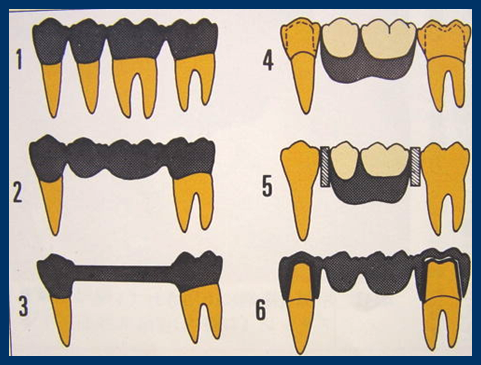
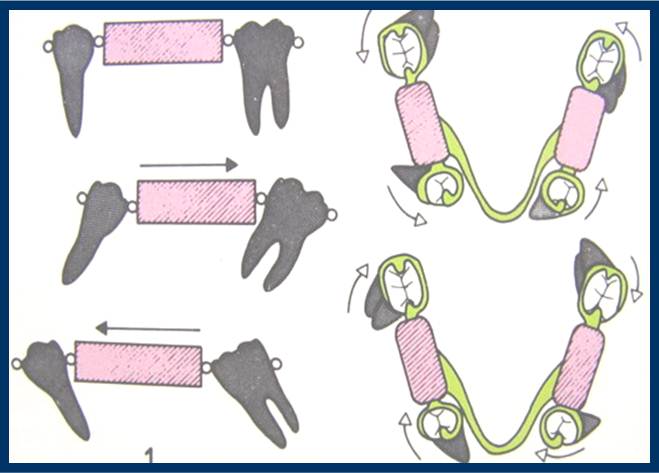
In Japan this technique is only known as Konus Krone, but in Germany there are many different kinds of telescope systems. It is extremely regrettable that incorrect Konus Krone treatment methods have spread across Japan and have caused the reputation of telescope dentures as a whole to suffer.
The Konus Krone textbook was translated into Japanese in the 1980s and for a while it was very popular among a portion of dentists here. But after only about 10 years its popularity waned. There were many problems with the treatment method and its reputation suffered. It is thought that the cause of these troubles was that the design, manufacturing method, metals used, applicable cases, and other such factors were not uniform in the Konus Krone method. As a result the technique gradually fell out of use.
2. How Konus Krone is handled in Germany
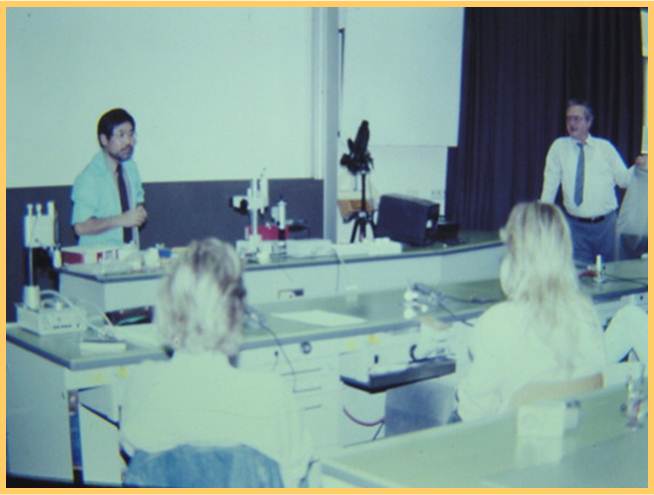
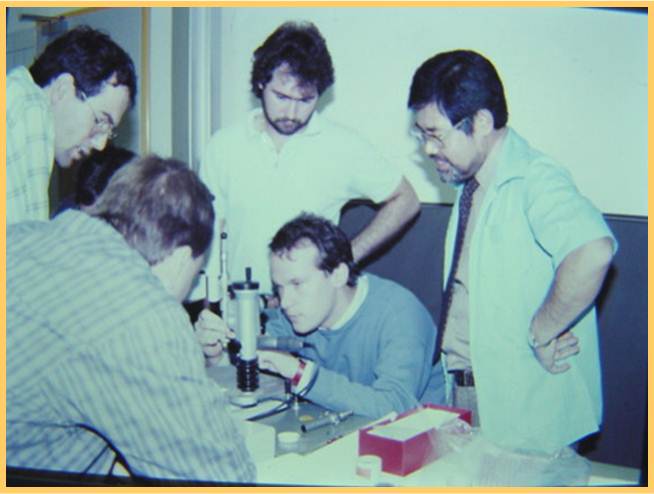
In Germany, Konus Krone is just one of many types of telescope systems. There was nothing particularly special about this treatment method.
I learned that by using not only Konus Krone, but also Riegel telescope, Resilience telescope, Anchor Band telescope, and a few other telescope techniques, I could treat almost any case. Riegel telescope especially proved to be applicable in many cases using both rotating Riegel and revolving Riegel. I was able to actually experience clinical care in Germany where these telescope systems were used. That experience is what I base my own clinical care on even today.
3. How Konus Krone is handled in Japan
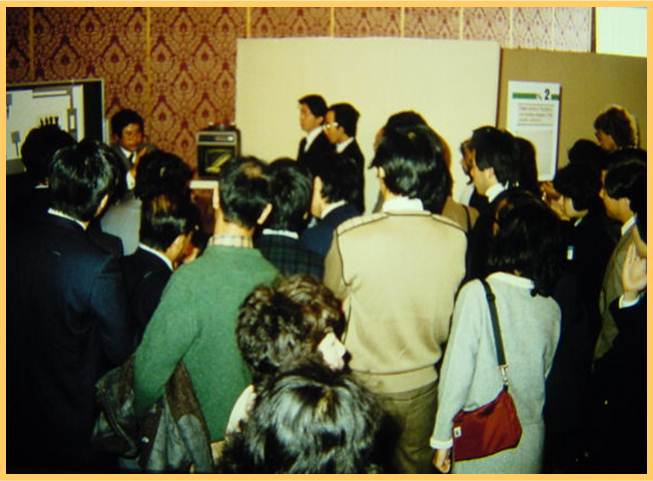
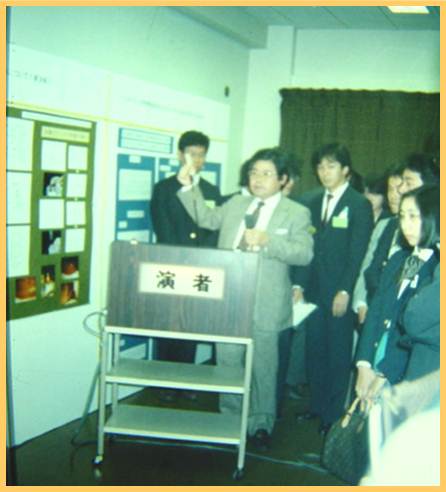
When I returned to Japan in 1980 this technique was beginning to spread among clinicians under the name Conus Crown. But the actual clinical procedures and manufacturing method was very different from what I had seen in Germany.
The metal being used in Japan was a gold and silver alloy called palladium. It kind of looked like the gold used in Germany, but it was not the same. At any rate it was quite different from the procedure that I learned in Germany.
The purity of the gold and silver palladium alloy degrades after long use. After seeing this I decided that I needed to spread the correct 'Konus Krone' technique so I published 'Konus Krone' and 'Riegel telescope' in the Shofu Color Atlas.
One big difference is that Japanese instructors were teaching that dentists should just remove the nerves from the teeth because of the large amount of filing necessary. Removal of nerves from the teeth became a big problem as the teeth would crack and the reputation of Konus Krone suffered greatly. In Germany, one of the rules of Konus Krone is that only teeth with nerves can be used as support foundations, but in Japan this was the complete opposite.
Moreover, it is necessary to understand the fundamentals of denture design in order to protect teeth, but in Japan these fundamentals were widely unknown. This was especially true for the 'torsion bar' and 'sparte', bed designs that prevent the breaking of teeth. These techniques were completely unknown in Japan and in fact no measures were put into place to prevent teeth from breaking.
With these fatal flaws, the number of dentists who treated with Konus Krone grew fewer and fewer.
4. How Konus Krone should be used from now on
On the other hand, there are many cases of the Konus Krone treatment method being used correctly and patients happily using their dentures even 30 years after first receiving treatment.
When I was studying under the auspices of Professor E. Koerber as a visiting professor at Tubingen University in Germany, I was fortunate enough to have experienced the telescope system being used to treat many cases and receive information first-hand.
It is our hope to continue to expand our offering of clinical services. Konus Krone is not the only type of telescope system that we use in our clinic. We also use Riegel telescope, Resilience telescope, and many other treatment methods chosen to suit each individual case. Moreover, in recent years we have been able to combine telescope system treatment with implants with favorable results. So we are very excited about future developments.
---------------------------------------------------------------------------------
An article that Dr. Inaba published at the time called 'Orthodox Konus Krone' has been made into a booklet!
It speaks in detail about the correct method of treatment. It contains details about the correct treatment method including the use of an occlusial core, the Konus milling machine, the correct impression method, set method, and many other such procedures.
The fundamental design of Konus Krone can be suited to all partial dentures.
This booklet is unattainable anywhere else. Please pick up a copy for your own reference (intended for dentists).
2015年2月10日
I have partial dentures. They make it difficult for me to talk and pronounce words correctly. It is quite troubling.
Q. My upper dentures are giving me trouble. I am missing 1 molar on the right side and 2 molars on the left side. I had partial dentures made about half a year ago, but the other day they began to feel really awkward. I can't talk or pronounce words correctly and it is really grieving me.
The bar in the upper jaw pops up and I have to support it with my tongue. I am forced to think about my dentures all day long.
When I bite into food, there is no taste and only pain. The dentist who made them for me told me I would get used to them but I have been practicing with them for 6 months now. What should I do?
A. Everyone experiences an awkward feeling when first getting dentures. But most people get used to them after some time.
But this actually depends on how well they fit with your own teeth.
Dentures that do not move around in the mouth are made on the premise that they should adhere to the point where air and water do not cause them to move. .
Some reasons why dentures fall out in the case of full dentures is that air gets under the inner edges, or the dentures lose muscle support because they are too small. In the case of partial dentures, with each bite, they wiggle around the clasps that support them. This eventually causes the denture to lose their tight fit.
Dentures that move around in the mouth like this require constant support from the tongue and in turn make it difficult for patients to get used to them.
Our clinic uses the German-developed telescope system. These dentures are made to prevent the teeth from wiggling as much as possible. If the dentures are not wiggling your teeth, this means that they fit well and will not move or fall out.
Even in the case of full dentures, we can make ones that do not allow air to get in. We do this by using the maxillomandibular simultaneous impression method modeled after Strack dentures. We use this method to make a complete copy of the inside of your mouth.
As for the thin pink bed of the dentures, by using a polymerization system called the Ivocup system, we are able to make a thin yet strong bed, which pleases our patients greatly.
Of course we also do a pronunciation check and make adjustments if there are any problems.
▼Regions that effect pronunciation
We conduct a pronunciation check by applying Vaseline to the palate of the dentures, sprinkling on some powder, and having the patient pronounce some words. Through this method we can locate regions of the palate that may be effecting pronunciation and then file them down. We can also make adjustments by adding to the shape of the palate.
2015年1月 5日
What do I need to prepare and how should I contact you before returning to Japan? (person living in Canada)
Q. I have been living in Canada for 5 years. At the moment I pretty much have no more upper teeth. I have been receiving treatment from a dentist ever since I was a child. Since my 20s, I have suffered from many problems with my mouth such as my molars gradually chipping away and my front teeth breaking. I received complete treatment around the age of 30. My teeth were OK for a while but gradually my false teeth and my crowns fell out. Last spring my teeth suddenly began to hurt and when I went to the dentist I learned that I had an infection in my teeth and they extracted 2 or 3 teeth from my upper right jaw. Today I have partial dentures. I feel pretty miserable with the whole situation. It has been about 6 months since I started wearing dentures.
My current diagnosis is:
1. The front teeth in my upper right jaw are crowned and have become loose. They won't last long so I was told I should have them extracted. The 2 teeth next to them (in the left jaw) are bridged so if I get these teeth extracted, I will need to have a new bridge made.
2. I need root canals in the crowned teeth in my lower left jaw.
3. I need to have two problematic wisdom teeth removed.
Do I really need to have more teeth extracted? I was so shocked when the dentist told me this. What would the dentists at Inaba Dental Clinic plan to do to treat my condition?
I would like to entrust my future denture needs to the dentists at Inaba Dental Clinic. I would also like to request information about what I need to prepare and how I should contact you before returning to Japan?
I also would like to ask about other treatments, but I am rather restricted with time, unfortunately. It would really boost my confidence if you could tell me a little about other treatment options. What troubles me the most is that I don't know what treatment method to go forward with. As it is, the next step for me is to see a dentist and have my teeth extracted (I really don't want to have any more teeth taken out and I am skeptical as to whether or not that is the only option). The extraction recommended to me will leave me with no top teeth from the 2nd front tooth to the second to last molar on the right side. They want to give me some type of plastic teeth which really doesn't sit well with me.
A. Thank you for your questions. It must be quite an ordeal to have to undergo so much dental treatment and get partial dentures despite being consistent in caring for your teeth since your 20s. I can imagine that the news you received from your dentist has been another source of anxiety.
1. The front teeth in my upper right jaw are crowned and have become loose. They won't last long so I was told I should have them extracted. The 2 teeth next to them (in the left jaw) are bridged so if I get these teeth extracted, I will need to have a new bridge made.
2. I need root canals in the crowned teeth in my lower left jaw.
3. I need to have two problematic wisdom teeth removed.
It seems that you received a lot of advice about what you should do. But what worries me is that you mentioned the dentist told you nothing about what to do once you have your teeth extracted. I think that it should be your top priority to ask what you should do after extraction before you have anything done. If you don't discuss beforehand whether you should choose implants or false teeth then it is no wonder you feel stressed. Losing your teeth and having nothing in there to fill the gap is enough to put your life on hold. You can't eat properly and communication becomes incredibly difficult.
If you are not experiencing any pain then it is OK to wait on the extraction. It is important to confirm that you will have false teeth put in soon afterwards though.
You say that you pretty much have no more upper teeth, but I would like to know exactly how many you have left. If you only have a few left, it may not be wise to put any more stress on them.
There is a German developed method called Resilience telescope that is appropriate for cases in which only a few teeth remain.
It is the most requested method at our clinic because there is no need to have dentures remade every time you lose a tooth. These dentures are also very popular due to their esthetic beauty.
Even if you choose the Resilience telescope method, you will need to visit our clinic at least 4 times. Since you live in Canada, this may be rather difficult. But if you can make it out here, we would be very happy to treat you. 4 times is a lot to ask, but it is certainly possible for us to help you if you can give us 3 - 4 months of your time, set up a plan, and focus on completing treatment.
It may not be easy, but please look further into it.
If you can provide just a little more information, such as the number of upper and lower teeth you have and whether or not they still have nerves, I can give you better advice about a concrete method. Please contact us.
Since you live so far away, it is certainly possible to conduct consultation through mail. I hope that we can assist you.
Please take care of yourself.

